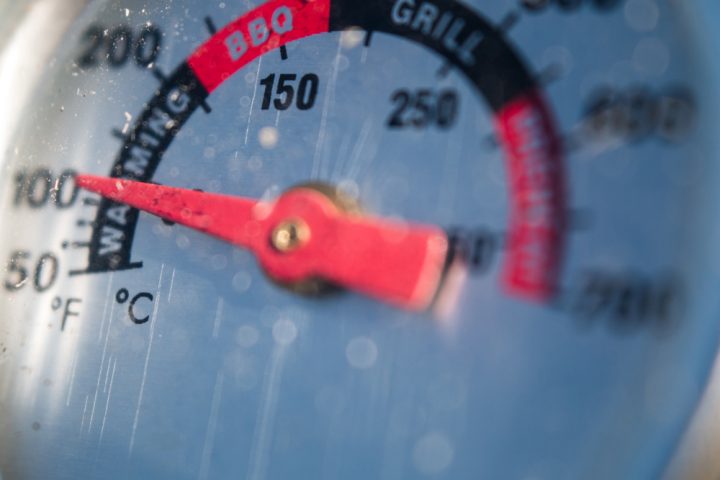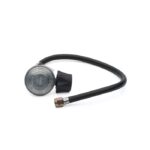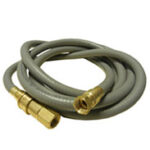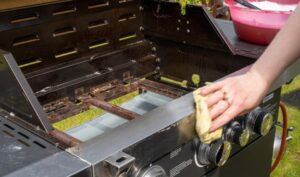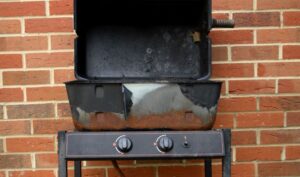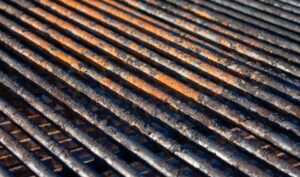The Complete Guide to Troubleshooting Gas Grill Issues is your source for step-by-step instructions on how to diagnose and fix the most common gas grill issues. Whether your grill isn’t heating properly, won’t stay lit, or simply has rusty parts, we’ve got the answers you need to get your gas barbecue firing on all cylinders.
Your veggies are prepped, your meat has been marinating for the last eight hours, and it’s time to fire up the grill—or not. Few things are more disappointing to grillers than a gas grill that won’t get hot enough.
If your barbecue ignites properly but you’re getting a low flame on your gas grill that won’t increase no matter what you do, don’t panic. A low flame on a gas grill is usually caused by a few easy-to-resolve issues:
- There are problems with the tank
- Your grill is in bypass mode
- There’s a gas leak
- The regulator is malfunctioning
In this section of the Complete Guide to Troubleshooting Gas Grill Issues, we’ll explore the reasons why you may be experiencing low flame on a gas grill and how to fix it. Let’s get cooking.
4 Reasons Your Gas Grill Won’t Get Hot Enough
1. There are problems with the tank
If there isn’t enough propane in the tank or there is a problem with the tank, this can result in low flames. If you have one, check that the fuel gauge is giving you an accurate read—a full tank of propane weighs close to 38 lbs. An empty tank is closer to 18lbs. If it has enough fuel in it, check the tank for its expiration date, dents, and rust. If the tank is expired, dented, or badly corroded, it’s time to switch it out for a new one.
2. Your grill is in bypass mode
Gas grills come with a safety feature called an Overfill Prevention Device (OPD). If the OPD detects an overfill of gas, it will immediately reduce the amount of gas passing into your grill, resulting in a low flame and a grill that can’t get hotter than 250-300 degrees.
There are a few things that can trigger bypass mode resulting in a low flow of gas:
- Opening the valve too quickly.
- Turning the burners on before opening the propane tank.
- Turning the propane off before the knobs.
- Leaving the control knobs turned on after grilling.
The good news is that you can quickly reset your OPD and restore normal flow by following these steps:
- Open the grill lid.
- Turn off the gas at the propane tank.
- Disconnect the gas line from the tank.
- Turn all the control knobs up to high, including your side burner if you have one.
- Wait for one full minute, then turn all the control knobs off.
- Reconnect the gas line to the propane tank and slowly turn the gas on at the tank.
- Light your grill.
After following these steps, your barbecue should light up and heat normally. If it’s still not operating properly, you may have a leak or a faulty regulator.
3. There’s a gas leak
Gas leaks can be caused by a loose connection or a damaged gas hose. To check your grill for gas leaks, follow these steps:
- Mix a 50/50 solution of soap and water.
- Brush the solution onto your gas hose and any connection points.
- Open your gas supply. If there are leaks, you will see bubbles forming at the source of the leak.
- Close the gas supply.
If you see bubbles, determine the source:
- If you see bubbles coming from a connection point, disconnect and reconnect your hose. Run the test again. If you still see bubbles, tighten the gas hose and regulator.
- If they are coming from the hose, replace the hose.
Shop for replacement hoses:
4. The regulator is malfunctioning
The regulator is responsible for controlling the flow of gas from the source (propane tank or natural gas line) to the grill. If bypass mode hasn’t been accidentally triggered and there isn’t a gas leak, your grill’s regulator may be malfunctioning. Replacing a regulator is pretty straightforward:
- Ensure you have a new regulator that fits your gas grill.
- If it isn’t already off, turn off the gas to the grill.
- Remove the existing regulator—most simply twist off, but consult your manual if you aren’t sure.
- Install the new regulator.
- Check for leaks using soapy water.
Conclusion
There could be a few different reasons why your gas grill won’t get hot enough:
- There are problems with the tank
- Your grill is in bypass mode
- There’s a gas leak
- The regulator is malfunctioning
While a low flame on a gas grill can be frustrating, it is often easily and quickly fixed.
Still struggling with your grill? Learn more about different grill problems, what causes them, and how to solve them in our Complete Guide to Troubleshooting Gas Grill Issues.

